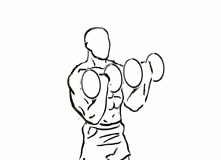Last Updated on September 26, 2014
The Single Leg Squat with Barbell is a powerful and advanced variation of the traditional squat. This challenging movement not only strengthens the legs but also enhances balance, stability, and coordination. By isolating each leg individually, it targets muscles more intensely while addressing potential imbalances in strength or mobility.
This guide dives deep into the Single Leg Squat with Barbell—its benefits, proper execution, common mistakes, and strategies to include it effectively in your fitness routine. If you’re an experienced lifter ready to level up your leg day, this is the perfect addition to your repertoire.
Why the Single Leg Squat with Barbell?
Squats are a staple of strength training, and the single-leg variation introduces a unique challenge. Here’s why this exercise deserves a spot in your routine:
1. Targeted Muscle Engagement
By focusing on one leg at a time, this exercise activates the quadriceps, hamstrings, glutes, and calves more intensely compared to bilateral squats.
2. Improved Balance and Stability
Balancing a barbell while performing a single-leg squat requires enhanced core engagement and coordination, improving overall stability.
3. Corrects Muscle Imbalances
Working each leg individually helps address discrepancies in strength or size between your left and right sides.
4. Builds Functional Strength
The movement mimics actions in sports and everyday activities, making it ideal for athletes or those looking to enhance their functional fitness.
5. Elevates Core Strength
The single-leg position and barbell load demand significant core activation to maintain proper posture and prevent tipping or twisting.
How to Perform the Single Leg Squat with Barbell
Step-by-Step Instructions
Follow these detailed steps to ensure proper form and maximize the benefits of this advanced movement:
1. Set Up Your Equipment
- Use a squat rack to safely position the barbell at shoulder height.
- Choose a barbell with a weight appropriate for your experience level—start light and progress as you gain confidence.
2. Position the Barbell
- Stand under the barbell and position it across your upper traps, just above your shoulders.
- Use a wide grip on the barbell for stability, with your hands slightly wider than shoulder-width.
3. Stabilize Your Core
- Brace your core by drawing your belly button toward your spine.
- Keep your chest up and shoulders back to maintain an upright posture.
4. Position Your Supporting Leg
- Cross your non-working leg over your supporting leg, placing your ankle above the knee of the supporting leg. This creates a figure-four position.
- The supporting leg should be slightly bent to prepare for the squat.
5. Perform the Squat
- Slowly lower your body by bending your hip and knee of the supporting leg.
- Descend as low as your mobility and strength allow, ideally until your thigh is parallel to the ground or lower.
- Keep your back straight and avoid leaning excessively forward.
6. Return to Starting Position
- Drive through your heel to straighten your knee and hip, returning to an upright position.
- Focus on maintaining control and balance throughout the movement.
7. Switch Legs
- Complete the desired number of repetitions on one leg, then switch sides and repeat.
Pro Tips for Proper Form
- Start with Bodyweight
If you’re new to single-leg squats, practice the movement without a barbell to build strength and balance. - Control the Descent
Avoid dropping into the squat too quickly. A slow, controlled descent engages your muscles more effectively. - Engage Your Core
Keep your core tight throughout the movement to stabilize the barbell and maintain proper alignment. - Keep Your Knee Aligned
Ensure your supporting knee tracks over your toes to avoid strain or injury. - Focus on Balance
Use a spotter or perform the exercise near a stable surface for added security while learning.
Common Mistakes to Avoid
Mastering the Single Leg Squat with Barbell requires attention to detail. Here are common errors to watch for:
- Using Too Much Weight
Overloading the barbell before mastering the movement can lead to poor form and increased injury risk. - Leaning Forward
Excessive forward lean shifts the load away from the targeted muscles and onto your lower back. - Unstable Barbell Position
Allowing the barbell to shift or wobble compromises your balance and increases the risk of strain. - Improper Knee Alignment
Letting your knee cave inward (valgus collapse) places unnecessary stress on the joint. - Skipping the Warm-Up
Failing to properly warm up your muscles and joints increases the likelihood of injury.
Muscles Worked
The Single Leg Squat with Barbell is a compound movement that targets multiple muscle groups:
- Primary Muscles:
- Quadriceps
- Gluteus Maximus
- Hamstrings
- Secondary Muscles:
- Calves
- Core (Abs and Obliques)
- Lower Back
- Stabilizing Muscles:
- Hip Abductors and Adductors
- Shoulders and Upper Back (to stabilize the barbell)
Who Should Perform This Exercise?
This exercise is best suited for individuals with prior experience in strength training, particularly those who have mastered the traditional squat. It’s ideal for:
- Athletes: Enhancing balance, agility, and unilateral strength for sports performance.
- Advanced Lifters: Adding variety and intensity to leg day routines.
- Rehabilitation: Correcting muscle imbalances or rebuilding strength after injury (under supervision).
Progressions and Variations
Progressions
- Bodyweight Single-Leg Squat
Master the movement without a barbell before introducing additional weight. - Dumbbell Single-Leg Squat
Hold a dumbbell in each hand for a slightly less intimidating progression than using a barbell. - Barbell Bulgarian Split Squat
Perform a supported version of the movement with your rear foot elevated on a bench.
Variations
- Pistol Squat with Barbell
Extend the non-working leg straight out instead of crossing it, increasing the challenge. - Safety Bar Single-Leg Squat
Use a safety squat bar to reduce strain on your shoulders and improve stability. - Smith Machine Single-Leg Squat
Perform the exercise using a Smith machine for added support and safety.
Reps and Sets Recommendations
Adjust the number of sets and reps to align with your fitness goals:
- For Strength: 3–5 sets of 3–6 reps per leg with heavier weight.
- For Hypertrophy (Muscle Growth): 3–4 sets of 8–12 reps per leg with moderate weight.
- For Endurance and Stability: 2–3 sets of 15–20 reps per leg with lighter weight.
Workout Integration
The Single Leg Squat with Barbell is a versatile movement that fits well into various workout routines:
- Leg Day Routine: Pair it with exercises like deadlifts, Bulgarian split squats, and leg presses.
- Full-Body Workout: Include it alongside upper-body exercises for a balanced routine.
- Athletic Training: Combine it with plyometric movements for explosive strength development.
Safety Considerations
- Warm Up Thoroughly
Perform dynamic stretches and light cardio to prepare your joints and muscles. - Use a Spotter
For added safety, especially when working with heavy weights, have a spotter assist you. - Maintain Proper Form
Prioritize form over weight to reduce the risk of injury. - Progress Gradually
Start with lighter weights and increase the load as your strength and confidence improve. - Rest Between Sets
Allow adequate rest (1–3 minutes) between sets to maintain performance and prevent fatigue.
Benefits Beyond the Gym
The benefits of the Single Leg Squat with Barbell extend beyond aesthetics and gym performance:
- Enhanced Athleticism: Improved balance and unilateral strength translate to better performance in sports.
- Injury Prevention: Strengthening stabilizing muscles reduces the risk of injuries during physical activities.
- Improved Daily Functionality: Building single-leg strength makes tasks like climbing stairs and lifting objects easier.
FAQs
1. Can beginners attempt this exercise?
This is an advanced movement. Beginners should focus on mastering bodyweight squats or Bulgarian split squats before progressing.
2. How often should I perform this exercise?
Include it 1–2 times per week as part of a lower-body workout, ensuring adequate recovery between sessions.
3. What weight should I start with?
Start with a lighter barbell or even an empty bar to practice the movement before adding weight.
Conclusion
The Single Leg Squat with Barbell is a challenging but rewarding exercise that tests your strength, balance, and coordination. By incorporating it into your routine, you can develop powerful, well-defined legs while improving overall athleticism and functional fitness.
Remember to prioritize proper form, progress gradually, and use appropriate safety measures to maximize results and minimize risks. Whether you’re an athlete, bodybuilder, or advanced fitness enthusiast, this exercise is a game-changer for building lower-body strength.
So, set up your barbell, focus on balance, and conquer the single-leg squat—one rep at a time!






